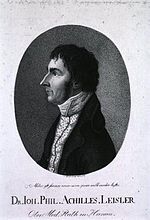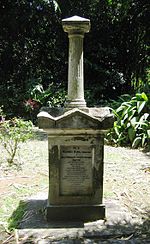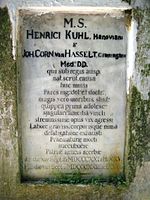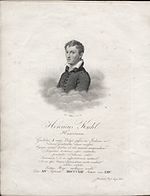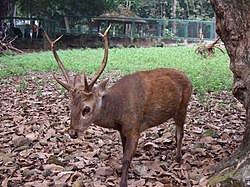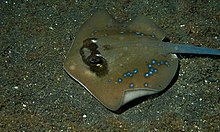Heinrich Kuhl

Heinrich Kuhl (born September 17, 1797 in Hanau , † September 14, 1821 in Buitenzorg , today Bogor ) was a Hessian , German naturalist and zoologist . His studies were mainly concerned with the anatomy of vertebrates , but he also worked in the fields of botany and mineralogy . Its official botanical author abbreviation is " Kuhl ".
Life
Parental home and school
Heinrich Kuhl was born as the second child of the Hanau city school leader Johann Heinrich Kuhl (1757–1830) and his wife Marie Judith Kuhl, née. Walther (1770–1810), born in Hanau am Main. Heinrich had eight siblings, three sisters and five brothers. The family was one of the descendants of Calvinist religious refugees who emigrated to Hanau from the Spanish Netherlands and who have been members of the Walloon parish in Hanau since then . The service language of the congregation was French and it can be assumed that French was spoken in the Kuhl family in addition to German . In addition, the tradition within the parish of giving French baptismal names was preserved. On September 24, 1797 Heinrich was baptized in the Walloon Church in the name of Jean Henry (Johann Heinrich). He was always quoted as Heinrich and he only used his middle name throughout his life.
Most likely, Kuhl spent his first school years in the Walloon School in Hanauer Neustadt, where Jacob Grimm was also taught. Later, he attended the High State School in Hanau, which it after obtaining the baccalaureate left in the year 1816th As a young student, Kuhl is said to have shown an extraordinary fondness for the natural sciences. His interests were promoted by some naturalists who were friends with his father, all of whom were members of the Wetterau Society founded in Hanau in the summer of 1808 . Here he was instructed by Philipp Gottfried Gärtner (1754-1825) in botany, Karl Caesar von Leonhard in geology and mineralogy, and Bernhard Meyer (1767-1836) and Johann Philipp Achilles Leisler in zoology. With the Hanau doctor Leisler, the young Kuhl had a paternal friendship and a weakness for birds and bats . After Leisler's early death in 1813, he took over his post as administrator of the zoological collection of the Wetterau Society as a schoolboy. At the same time he began his first manuscript on a monograph on bats, some of which was based on Leisler's ideas.
The connection with the Wetterau Society allowed Kuhl to make the acquaintance of well-known personalities such as Johann Wolfgang von Goethe , Prince Maximilian zu Wied-Neuwied or his later mentor Coenraad Jacob Temminck in the Netherlands at a young age . He also got to know Heinrich Boie in his youth, with whom he had a long-standing pen friendship and who would later even become his scientific successor.
Studied natural history and worked as a museum amanuensis
First, Kuhl decided to start studying natural history with Professor Friedrich Tiedemann at Heidelberg University . Giving in to the circumstances of the time , he wanted to take medicine as a so-called bread course , which should secure him sufficient income. The lucrative offer of the Dutch professor Theodorus van Swinderen (1784-1851) to study both natural history at the University of Groningen and to receive the well-paid post of museum manuensis quickly changed Kuhl. In September 1816 he began his studies in Groningen, where he attended the lectures of van Swinderen in natural history, Jacob-Baart de la Faille in physics, Gerbrand Bakker in anatomy and Petrus Driessen in chemistry and botany. The newly founded museum established itself ostensibly through Kuhl's collecting and cataloging work. On campus he met the medical student Johan Coenraad van Hasselt , with whom he became a deep friend from now on. Like Kuhl, van Hasselt was also very interested in natural history. At the beginning of his studies, Kuhl won first prize in a science competition at Groningen University and received a gold medal for it. In April 1819 the Senate of the university awarded him the honorary doctorate Matheseos Magister, Philosophiae Naturalis Doctor, honoris causa in absentia . However, Kuhl was only able to receive the honor personally in August after his return from England .
Study trips
To expand their knowledge, Kuhl and van Hasselt visited the most important museums and private collections in Germany , England and France at the time . They made the acquaintance of the leading scientists of the time. Her travels served on the one hand to improve anatomy knowledge with regard to her studies, but also for some zoological publications that were already planned. In the course of a three-month trip on foot through Germany, they came to the Berlin Museum in the summer of 1818 . Kuhl was particularly interested in looking through the rich collections of monkeys and birds. He received support and guidance at the museum from Martin Hinrich Lichtenstein and Karl Asmund Rudolphi . Further research led her to Lorenz Oken in Jena and to Friedrich Tiedemann and Heinrich Boie at Heidelberg University.
From April 1819, Kuhl spent several months in England. The stay served primarily to prepare for a prospective research trip to Southeast Asia. His research took him to Montagu House , later the British Museum , in London , where he was assisted by the zoologist William Elford Leach . During his studies at the Linnean Society , he made the acquaintance of the botanist James Edward Smith . The Society's first president allowed him to catalog a collection of birds from the Cook expeditions, which up to that point consisted of largely undescribed species. He found another friendly patron in the naturalist Joseph Banks , who allowed him to look through his botanical collections and use his private library in his own home.
The third study trip in November 1819 took Kuhl back to France together with van Hasselt. At the Natural History Museum in Paris, Kuhl met the natural scientists Étienne Geoffroy Saint-Hilaire and Jean-Baptiste de Lamarck . Kuhl particularly appreciated the friendly support and generosity of Alexander von Humboldt and Georges Cuvier . Humboldt, who was then staying in Paris, gave him access to the Paris Academy of Sciences and his private collection of writings. In the Cuvier house, Kuhl regularly took part in the scientific evening events held there. At the Paris Natural History Museum, Cuvier had all the cupboards opened for Kuhl's studies .
Certified commissie
The Dutch government around King Wilhelm I and the responsible Minister for Colonies, Anton Reinhard Falck , recognized Kuhl's value for their country early on. Their decision of May 2, 1820 founded the Natuurkundige Commissie voor Nederlandsch-Indië to research the Dutch colonies in the East Indian archipelago . Kuhl was appointed delegating member of the commission. Other members were van Hasselt, the Dutch taxidermist Gerrit van Raalten and his compatriot, the painter Gerrit Laurens Keultjes . The team was supposed to continue the work started by the German naturalist Kaspar Georg Karl Reinwardt in Java . According to a concept by Temminck, which became Kuhl's most important sponsor alongside van Swinderen, all research results and collectibles were to be transferred to the still-to-be-founded Reich Museum for Natural History in Leiden , whose curator Kuhl was intended to be.
The Java journey
On July 10, 1820, Kuhl and his companions boarded the ship Nordloh , which brought them safely to the port of Batavia on Java in December after stops in Madeira , Cape Town and the Cocos Islands on a six-month voyage . The local governor general van der Capellen assigned them accommodation in Buitenzorg , in the vicinity of which they immediately began their research.
The material of new plant and animal species collected from the surrounding highlands in the first four months was so enormous that Kuhl and his companions decided to determine a large part of it only after their return to Europe . With the end of the rainy season in April 1821, research into the large volcanoes in the south of Buitenzorg could begin. The province of Bantam , originally chosen as a collection area, had to be avoided because of an outbreak of cholera epidemic . In the following months they climbed the volcanic peaks of the Salak and the 3,019 m high Pangrango , of which Kuhl and van Hasselt are considered to be the first to climb .
After the strenuous ascent to Pangrango at the beginning of August, Kuhl and his companions were surprised by a violent storm, so that they returned to Buitenzorg wet and hypothermic. 14 days later, Kuhl developed severe diarrhea and a liver infection . After four painful weeks in the sick bed, Heinrich Kuhl died on September 14, 1821 in Buitenzorg. On the instructions of van der Capellen, Kuhl was buried in the Botanical Garden of Buitenzorg, not far from the Governor General's summer palace . The Belgian colonial painter Antoine August Joseph Payen was commissioned to design a tomb. As director of the Botanical Garden, Reinwardt designed a grave tablet with an inscription, which was replaced by a new one after van Hasselt's funeral and which has been preserved to this day.
Scientific importance
The material collected by Kuhl and his companions in Java consisted of 200 skeletons and 200 skins from 65 mammal species , 2,000 bird skins , 1,400 fish from 420 species, 300 amphibians and reptiles from 90 species as well as many insects and mollusks . There are also many manuscripts that have already been started and a total of 1,200 animal and plant drawings. The animals collected formed an important basis for the zoological collection of the Leiden Natural History Museum ( Rijksmuseum van Natuurlijke Historie ), now Naturalis . Due to his early death, Kuhl was no longer allowed to work on this collection scientifically. In his function as museum director in Leiden Temminck himself only described a few pieces. He left the processing to other scientists, some of whom did not work at the Leiden Museum. For example, Heinrich Boie, Kuhl's successor as curator at the museum since 1821, continued the classification he had begun of the amphibians and reptiles found in Java and thus found one of his most important areas of research, herpetology . The freshwater and saltwater fish were worked by Cuvier and Achille Valenciennes in Paris. Wilhem de Haan dealt with the insects and other arthropods , Jan Adriaan Herklots with the echinoderms . The herbarium collected by Kuhl and van Hasselt in Java was largely described by Carl Ludwig Blume , a few orchids by Jacob Gijsbert Samuel van Breda . A large part of the Javanese collection remained unprocessed in the museum archives for many years.
As a pupil and student, Kuhl published a number of writings. His much-cited first work The German Fledermäuse was published in Hanau in 1817. The contributions to zoology and comparative anatomy and the Conspectus Psittacorum , a comprehensive monograph on the parrot family, which appeared in 1820 , brought him general scientific recognition. His research reports, written in letters, which contained a large number of newly written animal and plant species from Java, could only be published posthumously in the scientific journals Algemene Konst-en Letter-Bode ( Haarlem , 1788–1859), Isis von Oken ( Leipzig ) and Bulletin des sciences naturelles et de géologie (Paris). With his writings as a whole, Kuhl provided scientific descriptions of over 250 vertebrate species , of which more than 70 species are still valid today. From him, for example, the description of the Canadian beaver Castor canadensis Kuhl , 1820, the little noctule Nyctalus leisleri ( Kuhl , 1817) or the Geoffroy spider monkey Ateles geoffroyi ( Kuhl , 1820) come.
Kuhl's work served as a role model for numerous other naturalists from the Naturalist Commissie such as Boie, Heinrich Christian Macklot , Salomon Müller or Franz Wilhelm Junghuhn , all of whom except Müller lost their lives on Java. To appreciate its scientific importance, van Swinderen compared his student Heinrich Kuhl with the Berlin naturalist Peter Simon Pallas . He was of the opinion that Kuhl would have become the bigger of the two if he had been allowed to live longer. Temminck believed the world had lost another Linnaeus in his untimely death . Despite his young age, Kuhl was a member of various natural research societies such as the Wetterau Society for All Natural History or the Society for the Advancement of All Natural Sciences in Marburg. In 1818 he was elected a member of the Leopoldina .
Honors
In honor of Heinrich Kuhl, a memorial plaque was placed at the former location of the house where he was born in Hanau, Am Markt No. 14. The building, which was destroyed in the Second World War , has been replaced by a modern successor building.
In addition, numerous animal and plant species have been named in his honor, a number of which have now been synonymous . The valid species that still bear his name today include:
Vertebrates
Amphibians
- Kuhl's brook or wart frog Limnonectes kuhlii ( Tschudi , 1838)
fishes
- Family of the flag tails Kuhliidae Jordan & Evermann , 1896
- Genus of flag tails Kuhlia Gill , 1861
- Gray or Kuhl's stingray Neotrygon kuhlii ( Müller & Henle , 1841)
- Kuhl's devil ray Mobula kuhlii ( Müller & Henle , 1841)
- Spotted thorn-eye or Kuhl's loach, Pangio kuhlii Valenciennes , 1846
- Kuhl's dragon head Pontinus kuhli ( Bowdich , 1825)
Reptiles
- Kuhl's folded gecko Ptychozoon kuhli ( Stejneger , 1902)
- Winkelkopfagame Gonocephalus kuhlii ( Schlegel , 1848)
Mammals
- White-rimed bat Pipistrellus kuhlii Kuhl , 1817
- Bawean deer Axis kuhlii ( Müller , 1840)
- Great cow monkey, Callithrix kuhlii Coimbra-Filho , 1985
- Little Yellow Bat Scotophilus kuhlii Leach , 1821
Birds
- Kuhl's pink cockatoo Eolophus roseicapilla kuhli ( Mathews , 1912)
- Kuhls or Rubinlori Vini kuhlii ( Vigors , 1824)
- White brewing Buzzard Leucopternis kuhli Bonaparte , 1850
Invertebrates
- Mantis Parablepharis kuhlii de Haan , 1842
- Silk spider Nephila kuhlii ( Doleschall , 1859)
- Black and white spider spider Gasteracantha kuhlii ( Koch , 1838)
- Ghost crab Ocypode kuhlii de Haan , 1835
- Comb jellyfish Eurhamphaea kuhlii ( Eschscholtz , 1829)
- Starfish Neoferdina kuhli ( Müller & Troschel , 1842)
- Starfish Linckia kuhli from Martens , 1866
- Flatworm Diversibipalium kuhlii Loman , 1890
plants
- Kuhl's wax flower Hoya kuhlii Koorders , 1912
- Ivory pipe palm Pinanga kuhlii flower , 1839
- Kuhl's grape oat, Danthonia kuhlii Steudel , 1854
- Orchid genus Kuhlhasseltia Smith , 1910
- Lebermoosart Plagiochila kuhliana ( Sande Lacoste , 1863)
- Deciduous moss species Pinnatella kuehliana ( Bosch & Sande Lacoste , 1863)
Most important publications by Heinrich Kuhl

- 1817: The German bats. Hanau, [sn], 67 p., 2 fold-out sheets. (Digitized version ) (two-part version in: Annals of the Wetterauische Gesellschaft für die Gesamt Naturkunde. Hermannsche Buchhandlung, Frankfurt 1819, Vol. 4 (1), pp. 11–49 & Vol. 4 (2), pp. 185–215, Taf . XXII, XXIII, XXV. (Digitized version )
- 1818: HENRICI KUHL math. et phys. stud. in academia Groningana, Responsum ad quaestionem, ab ordine disciplinarum mathematicarum et physicarum propositam… Annales Academiae Groninganae 1816–1817, Jan Oomkens, Groningen, pp. 85–125. (Digitalisat) (Abstract Remarks on the characters and affinities of the orders. In: Thomas Edward Bowdich : An analysis of the natural classifications of Mammalia. Paris 1821, pp. 106-115. (Digitalisat) )
- 1820: Buffoni et Daubentoni figurarum avium coloratarum nomina systematica. Collegit Henricus Kuhl, Math. Mag. Phil. Nat. Doctor. Edidit, praefatione et indicibus auxit Theodorus van Swinderen, in Academia Groningana Professor Ordinarius. Jan Oomkens (Ed.), Groningen, 26 p. (Digitized version )
- 1820: Conspectus Psittacorum: cum specierum definitionibus, novarum descriptionibus, synonymis et circa patriam singularum naturalem adversariis, adjecto indice museorum, ubi earum artificiosae exuviae servantur. Nova Acta Physico-Medica, Academiae Caesareae Leopoldino-Carolinae Naturae Curiosorum, Adolph Marcus (Ed.), Bonn, 10 (1), pp. 1–104, plates 1–3. (Digitized version) (Als Separata , Bonn 1820, 104 p. (Digitized version) )
- 1820: Contributions to zoology and comparative anatomy. First division. Contributions to zoology. Verlag der Hermannschen Buchhandlung, Frankfurt / Main, 152 pp. (Digitized version) (various chapters also as separate files (digitized version) )
- Kuhl & van Hasselt 1820: Contributions to zoology and comparative anatomy. Second division. Contributions to comparative anatomy. Verlag der Hermannschen Buchhandlung, Frankfurt / Main, 212, p. 11 plate (digitized)
literature
Biographical literature
- Rudolf Bernges: Heinrich Kuhl - On the centenary of his death on September 14, 1821. In: Hanauer Anzeiger . September 14, 1921.
- Ludwig Gebhardt: Kuhl, Heinrich. In: New German Biography (NDB). Volume 13, Duncker & Humblot, Berlin 1982, ISBN 3-428-00194-X , p. 251 ( digitized version ).
- Maurist Greshoff: Kuhl en van Hasselt. One period in the Dutch-Indian Natuuronderzoek. Album der Natuur, Haarlem 1903, pp. 1–22, 60–88. (Digitized version)
- Wilhelm Hess : Kuhl, Heinrich . In: Allgemeine Deutsche Biographie (ADB). Volume 17, Duncker & Humblot, Leipzig 1883, p. 318.
- Thomas Hildenhagen: The short life of Dr. hc Heinrich Kuhl (1797–1821) and his herpetological contributions. Secretary , Rheinbach, 10 (2), 2010, pp. 59-62.
- Thomas Hildenhagen: Heinrich Kuhl - The life of an almost forgotten naturalist from Hanau. New magazine for Hanau history , HGV 2013, pp. 110–214.
- Karl Wilhelm Justi : Basis for a Hessian scholar, writer and artist story. Chr. Garthe, Marburg 1831, pp. 375–386. (Digitized version) .
- Charles Klaver: Inseparable friends in life and death. Barkhuis, Groningen 2007 (digitized version )
- Werner Kurz: From the old town of Hanau to the distant Dutch East Indies. In: Hanauer Anzeiger. September 6, 2008, p. 33.
- Karl Siebert: Hanauer biographies from three centuries. Hanauer Geschichtsverein, Hanau 1919 (= Hanauer Geschichtsblätter NF 3/4 ), p. 115f.
- Marius Jacob Sirks: Indian Natuuronderzoek. Academisch Proefschrift, Ellerman, Harms & Co., Amsterdam 1915, pp. 97-108. (Digitized version)
- Maria Johanna van Steenis-Kruseman: Flora Malesiana. Cornelis GGJ van Steenis (ed.), Nordhoff-Kolff NV, Djakarta (Jakarta) 1950, Ser. 1 (1), p. 303. (digitized version)
- Theodorus van Swinderen (a): Bijdragen tot eene schets van het leven, het karakter en de merits van wijlen Dr. H. Kuhl. Almanac of the Academy of Groningen, Jan Oomkens (Ed.), Groningen 1823.
- Theodorus van Swinderen (b): Vita Henrici Kuhlii. Nova Acta Physico-Medica, Academiae Caesareae Leopoldino-Carolinae Naturae Curiosorum, Bonn 1823, Vol. 11, pp. XLI-LXIV. (Digitized version)
Further literature
- Algemeene Konst-en Letter-Bode: Berierter. Haarlem 1819, vol. 2, p. 1.
- Algemeene Konst- en Letter-Bode: Berierter. Haarlem 1823, vol. 2, p. 321.
- Bo Beolens, Michael Watkins, Michael Grayson: The Eponym Dictionary of Mammals. Johns Hopkins University Press, Baltimore 2009, p. 231. (digitized version)
- Carl Ludwig Blume : Bijdragen tot de flora van Nederlandsch Indië. Ter Lands Drukkerij, Batavia (Jakarta) 1825-26, 3 vol. Vol. 1 , vol. 2 , vol. 3
- Carl Ludwig Blume : Enumeratio plantarum Javae et insularum adjacentium minus cognitarum vel novarum ex herbariis Reinwardtii, Kuhlii, Hasseltii et Blumii. JW van Leeuwen (ed.), Lugduni Batavorum (Leiden) 1827–28, 2 vols. Volumes 1 & 2
- Jakob Gijsbert Samuel van Breda: Genera et species orchidearum et asclepiadearum quas in itinere per insulam Java / Collegerunt H. Kuhl et JC Van Hasselt. JGS van Breda (Ed.), Gandavi (Gent) 1827 (digitized version )
- Georges Cuvier, Achille Valenciennes: Histoire naturelle des poissons. FG Levrault (Ed.), Paris 1828–49, 22 vols. (Digitized version )
- Otto Finsch: On the exploration history of the Ornis Javas. Journal for Ornithology, Leipzig 1906, Vol. 54, pp. 301–321. (Digitized version)
- Jan-Peter Frahm , Jens Eggers: Lexicon of German-speaking bryologists. Botanical Institute of the University of Bonn 1975, Vol. 2, pp. 261–262. (Digitized version)
- Charles Fransen, Lipke Bijdeley Holthuis , Janneke Adema (1997): Type-catalog of the Decapod Crustacea in the collections of the Nationaal Natuurhistorisch Museum, with appendices of pre-1900 collectors and material. Zoologische Verhandelingen, Leiden 1997, 311, pp. 1-344. pdf
- Johann Daniel Ferdinand Neigebaur: History of the Imperial Leopoldino-Carolinian German Academy of Natural Scientists. Friedrich Frommer (Ed.), Jena 1860. p. 267.
- Johann Peter Thyriot: The streets and houses of the city of Hanau. In: Festschrift of the HGV on the 600th anniversary of the elevation of Old Hanau to the city. HGV, Hanau 1903, pp. 34-56.
- Huibert Johannes Veth: Overzicht van hetgeen, in het bijzonder door Nederland, gedaan is voor de kennis der fauna van Nederlandsch-Indië. Academisch Proefschrift, Leiden 1879.
Web links
Remarks
- ↑ Hildenhagen 2013, p. 116.
- ↑ Hildenhagen 2013, p. 117.
- ↑ Grimm was taught in the so-called Gaquoin school from 1790-91, cf. Thyriot 1903, p. 52.
- ↑ Bernges 1921.
- ↑ van Swinderen 1823b, p. XLI.
- ↑ Justi 1831, p. 376.
- ↑ van Swinderen 1823b, p. XLIII.
- ↑ The museum holdings were completely destroyed in a fire in 1906.
- ↑ Kuhl 1818.
- ↑ Alg. Konst Let.-Bode 1819, p. 1.
- ↑ van Swinderen 1823b, p. LII.
- ↑ Acknowledgments in the foreword to the contributions to zoology ... , Kuhl 1820.
- ↑ Veth 1879, p. 21.
- ↑ Hildenhagen 2013, p. 163.
- ↑ van Swinderen 1823b, p. LVI.
- ↑ Hildenhagen 2013, p. 166, 191 (van Raalten and Keultjes are nevertheless considered to be the first to climb).
- ↑ van Swinderen 1823b, p. LVIII (Keultjes died 2 days later).
- ↑ Alg. Konst Let.-Bode 1823, p. 321.
- ↑ The shiploads with the material reached the Leiden Museum in 1824-25, cf. Hildenhagen 2013, p. 183.
- ↑ Naturalis Vertebrate Collection (digitized version) .
- ↑ Boie's manuscript Erpétologie de Java was based on Kuhl's notes, but has not yet been published, cf. Hildenhagen 2010, p. 54.
- ↑ Cuvier & Valenciennes: Histoire naturelle des poissons .
- ↑ Blume 1825-26, Blume 1827-28 and van Breda 1827.
- ↑ For example, in 1906 Otto Finsch found 68 bird species already described and given new names during cataloging work in Kuhl's notes, but these were ignored, cf. Finsch 1906, p. 317.
- ↑ The Leopoldina awarded Junghuhn for his deep admiration for the Cognomen Kuhl , cf. Neigebaur 1860, p. 267 & Hildenhagen 2013, p. 191.
- ↑ Member entry of Heinrich Kuhl at the German Academy of Natural Scientists Leopoldina , accessed on May 17, 2016.
- ↑ in the same year as Goethe, 50 years his senior!
- ↑ Current reports from the city of Hanau [1] .
- ^ Frost, Darrel R .: Limnonectes kuhlii (Tschudi, 1838). In: Amphibian Species of the World 5.6, an Online Reference. American Museum of Natural History, 2013, accessed April 4, 2014 .
- ↑ pontinus kuhlii (Bowdich, 1825) World Register of Marine Species.
- ↑ Ptychozoon kuhli in Reptile Database
- ↑ Gonocephalus kuhlii in The Reptile Database
- ↑ Kuhl did not name the species after himself, but took over a manuscript name already given by Johann Natterer , cf. Kuhl 1817, p. 57.
- ^ Chiroptera Specialist Group 1996. Scotophilus kuhlii Leach, 1821 . 2006 IUCN Red List of Threatened Species.
- ^ Tree of Life Web Project Parablepharis kuhlii de Haan, 1842
- ↑ iNaturalist.org Gasteracantha kuhlii Koch, 1838
- ^ Ocypode kuhlii de Haan, 1835 World Register of Marine Species
- ↑ Eurhamphaea Gegenbaur, 1856 World Register of Marine Species
- ↑ Neoferdina Livingstone, 1931 World Register of Marine Species
- ↑ Linckia kuhli von Martens, 1866 World Register of Marine Species
- ↑ Diversibipalium kuhlii (Loman, 1890) World Register of Marine Species
- ↑ The International Plant Name Index Pinanga kuhlii Blume, 1839
- ↑ JSTOR Global Plants Danthonia kuhlii Steudel, 1854
| personal data | |
|---|---|
| SURNAME | Kuhl, Heinrich |
| BRIEF DESCRIPTION | German zoologist |
| DATE OF BIRTH | September 17, 1797 |
| PLACE OF BIRTH | Hanau |
| DATE OF DEATH | September 14, 1821 |
| Place of death | Bogor |

